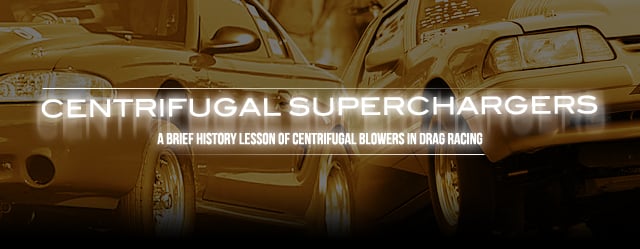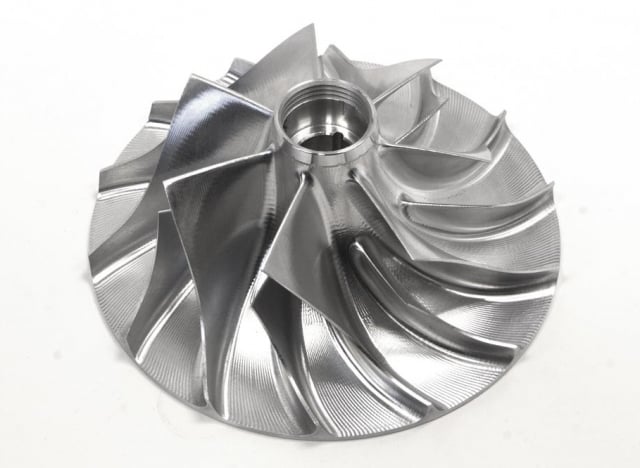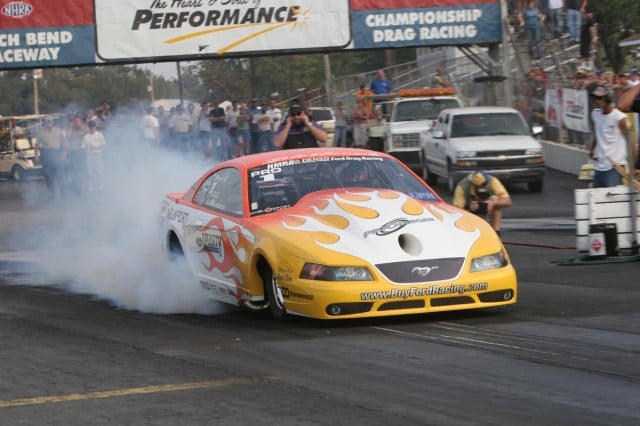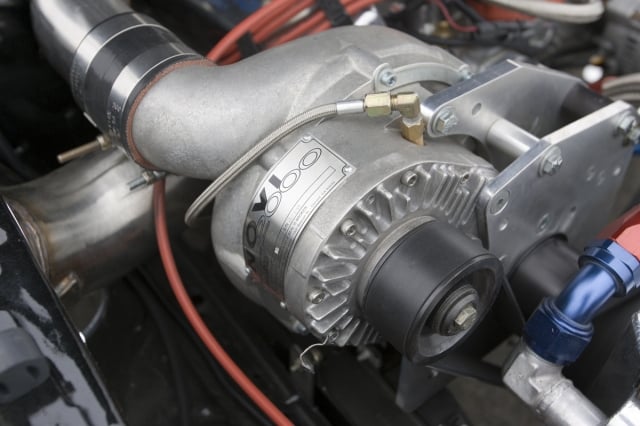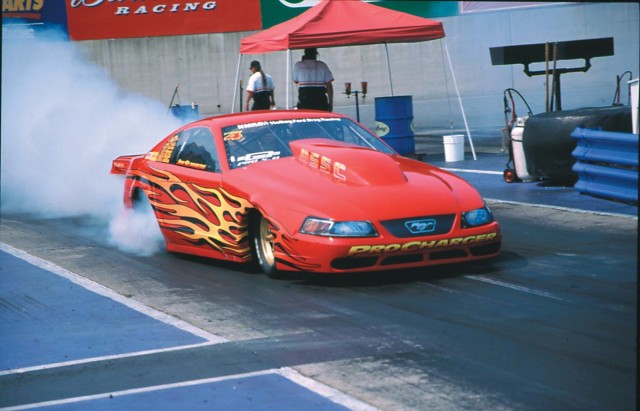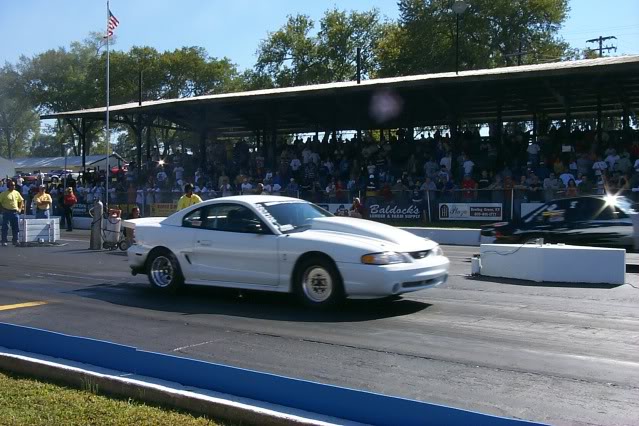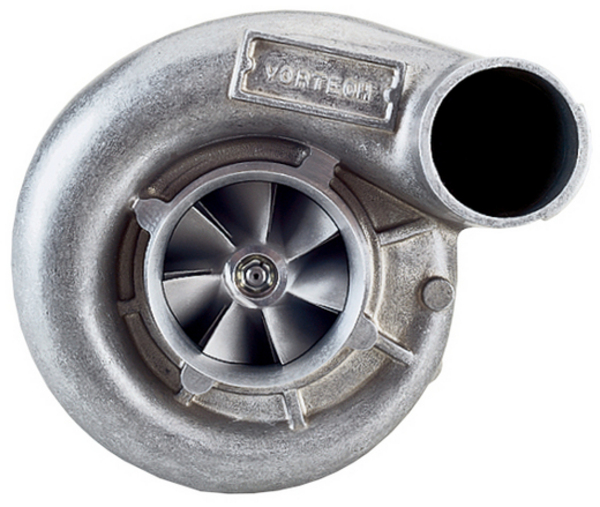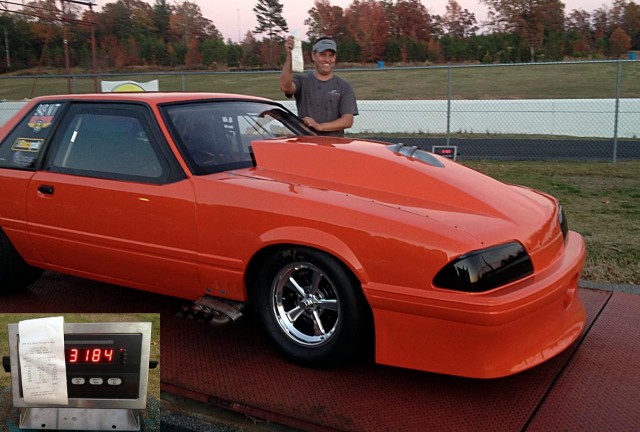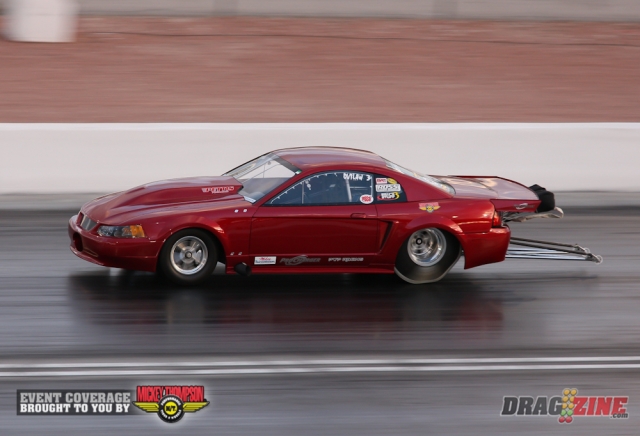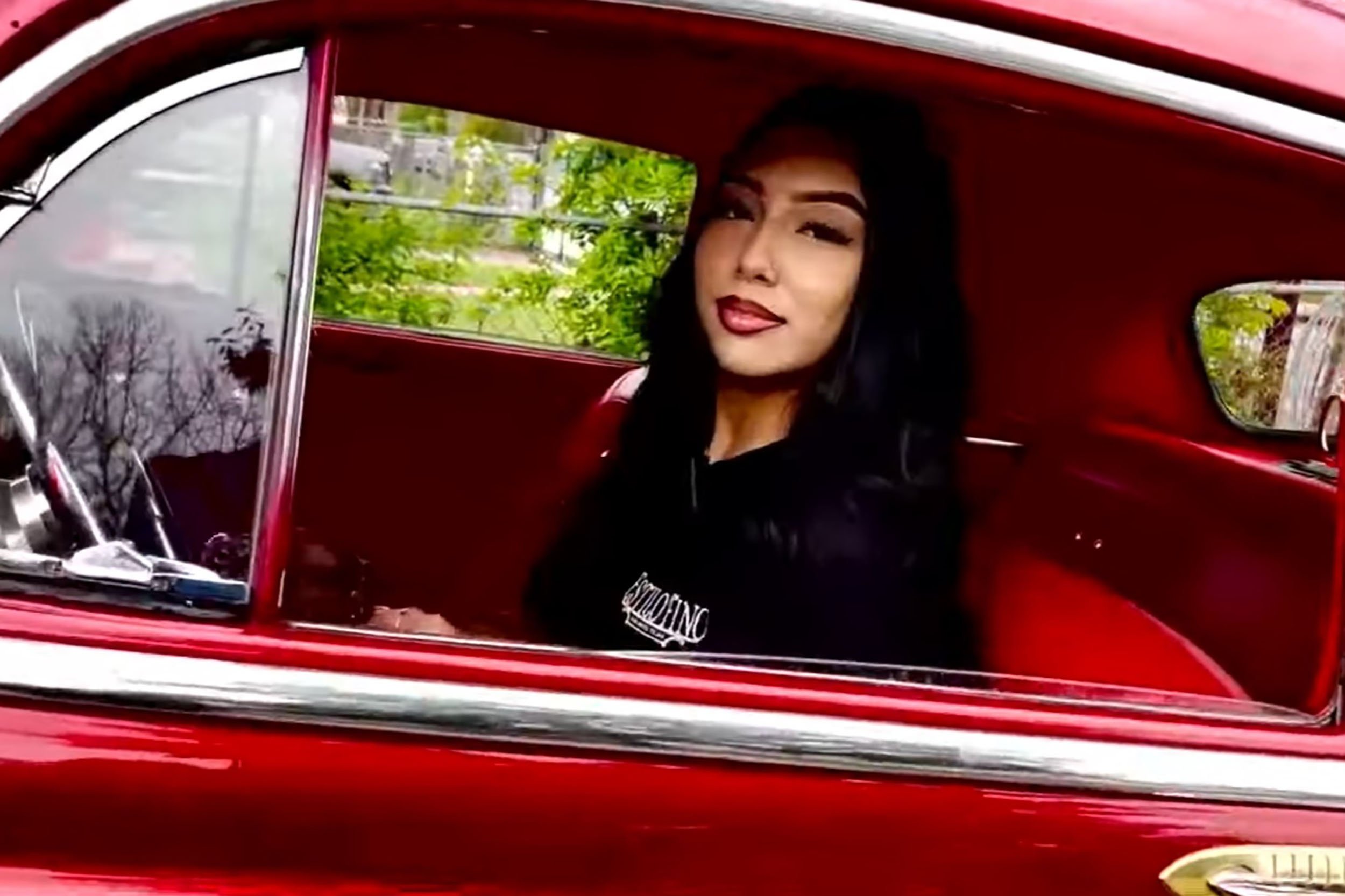The centrifugal supercharger is a simple device in theory – it sucks, then it blows. Air, that is. Of course it’s quite a bit more complicated in practice, but one thing is for sure – the centrifugal supercharger has been very, very successful in racing circles, especially over the last two decades or so as computerized flow modeling and modern engineering and machining processes have improved the quality of the product offered by a number of different manufacturers.
Records have been crushed in many instances by racers who are still competing today with these awesome devices, and we thought it was time to take a quick walk back through history at those who have paved the way for the current generation of superstars. It is interesting to note that the majority of significant accomplishments were achieved by Mustang racers, as the centrifugal blower wars atop the small-block Ford platform drove nearly all of the research and development back then.
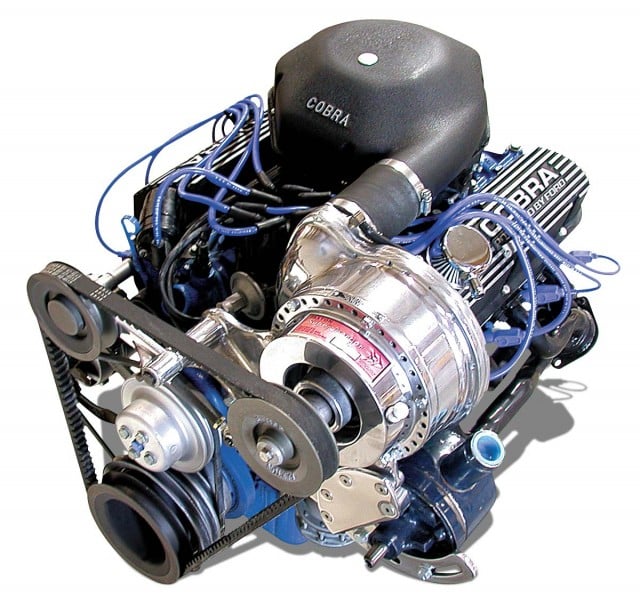
The Paxton ball-drive design installed on an automobile dates back to the 1950’s, and it was even used as original equipment on the mid-’60’s Shelby GT350 Mustang.
The centrifugal supercharger was originally designed back in the 19th century – 1899, to be exact, and evolved to the point where they were used extensively in piston-driven aircraft engines and sometimes even paired up with a turbocharger to maximize performance.
Centrifugal supercharging was adapted to the automotive platform and today has proven to be one of the preferred ways to make horsepower, especially in Outlaw-style and class racing. Three manufacturers stand out for specific reasons – Paxton Superchargers, Vortech Superchargers, and ProCharger Superchargers. All three companies have had their fair share of trend-setting accomplishments across the various racing classes, and in fact, it would be safe to say that small-tire racing might not exist if it weren’t for the Fox Mustang and the racers who campaigned them in those days.
Back In The Day: 1988-2003
A Paxton ball-drive supercharger was configured in a blow-through system for the ’66-’68 Shelby GT-350. Paxton Automotive enjoyed a long history of flirting with the automotive OEM’s to factory-install their superchargers, landing coveted OEM installs on the ’57 Thunderbird and as an option on the ’66-’68 Shelby GT-350, and kits were produced for the aftermarket for many different makes.
To make a long story short, I ended up leaving Paxton and opening up Vortech to build a supercharger design of my own. – Jim Middlebrook, Vortech Superchargers
By the mid-1980’s, JR Granatelli was at the helm of the company and building 50-state-legal 5.0L Mustang supercharger systems for public consumption. Those systems were based around a reciprocating ball-drive head unit called the SN-89. Subsequent versions of the supercharger were called the SN-92, SN-93, SN-2000, and NOVI-GSS, all of which were upgradeable to the 9-second-capable VR-4 supercharger. Street kits were crafted for each model year of EFI Mustang – the vehicle that brought aftermarket supercharging back to the forefront of the gearhead’s mind.
Jim Middlebrook, who was an engineer with Paxton at the time, had an idea of his own on how to construct a supercharger, and left the company, going out on his own to start Vortech Superchargers and usher in gear-driven centrifugal superchargers to the performance market.
“I wanted to improve the ball-drive design and thanks to a friend, Willie Mossman, had come across a foreign supercharger that was a gear-drive design. It was very noisy, but very durable as well. I tried suggesting it to the Granatellis, but at that time they were not interested in using the design, since it made so much noise. I actually started off selling Paxton superchargers as a dealer while designing and building the Vortech supercharger. I started in March, and by the time SEMA rolled around in December of that year, I had a Mustang kit and a Ford 460 kit,” said Middlebrook.
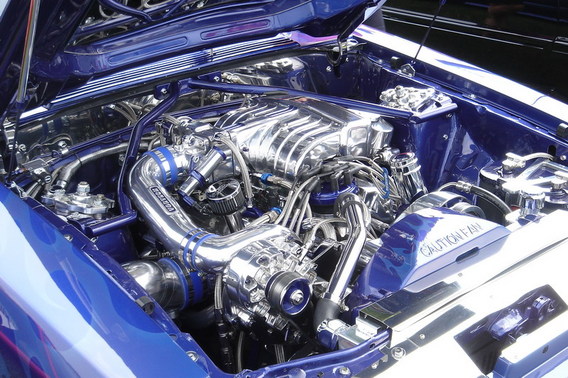
A typical Vortech A-Trim supercharger installation on a Fox Mustang – the A-Trim was Vortech’s first centrifugal supercharger. Image Credit: Vortech Superchargers
Later on, Paxton followed Middlebrook’s gear-driven Vortech design with their own NOVI-2000 helical-cut gear-driven blower. The VR-4, when raced on Dennis Hilliard’s Central Coast Mustang-backed entry, was good for 9.40’s and .50’s back then – the pinnacle of West Coast 5.0 performance.
Middlebrook’s idea to go off and start his own company to build a gear-driven supercharger proved to be a defining moment in racing supercharger history. The Vortech superchargers became well known for their reliability and power-making capabilities, despite the fact that those original designs so noisy, and they proved that reputation valid by dominating many race classes in the early years.
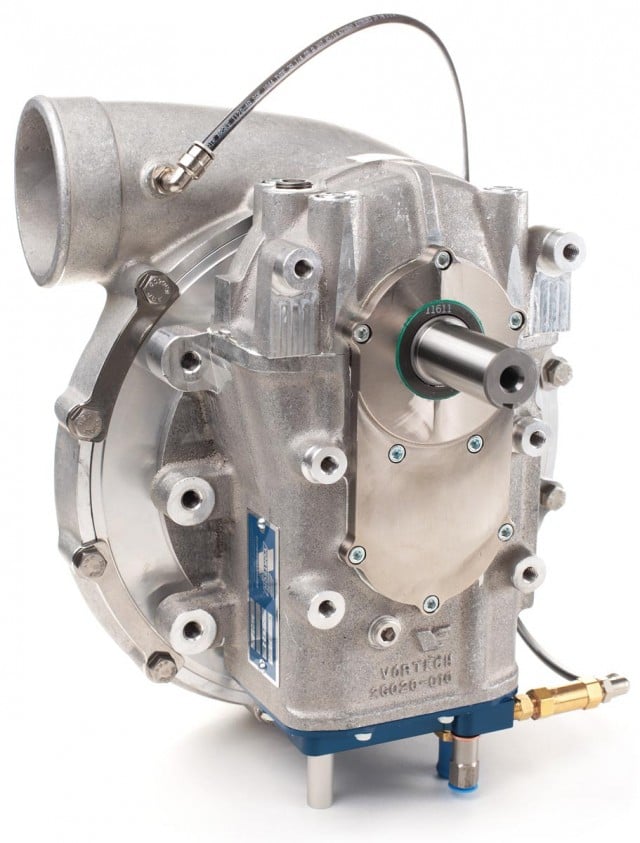
Vortech’s V-20 supercharger family includes the Xi, XB105, and V-28 123mm supercharger. It incorporates a special shaft support system to handle the speeds that racing superchargers require.
Back then, Paxton and Vortech battled it out for supercharger supremacy in the racing ranks with a variety of different designs; for Paxton it was the VR-4 and Novi 2000, while Vortech campaigned the ever-larger A, B, R, J, X, and XX-Trim superchargers. Years passed, Paxton was sold by the Granatelli family to David Adams, Jr., and eventually Middlebrook purchased Paxton from Adams and brought them all under one roof by the mid-2000’s.
Here Comes ProCharger
Meanwhile, the gang over at ProCharger showed up in the early 1990’s with their original P600B street supercharger design for the Mustang, the first centrifugal blower from an aftermarket company that was designed to use an intercooler right from the start. “In the early days, we had integrated intercooling while nobody else was offering intercooling, and instead were using ignition retard. It was a huge advantage on the street, but we didn’t really have a race blower at that time.
“We didn’t want to just do what everyone else was doing, but wanted to create something that was substantially better, and so the D-Series was born. The D stood for duplex, which referenced the bearing design – side-by-side bearings on the output shaft. That was the first race supercharger offered with a warranty back in 1999, and that was our first big racing innovation,” explained ProCharger’s Ken Jones.
We didn’t want to just do what everyone else was doing, but wanted to create something that was substantially better, and so the D-Series was born. – Ken Jones, ProCharger
From that moment on, it became a three-horse race, and within a season or two the Pro 5.0, Super Street, and Renegade classes had ProCharger superchargers running at or near the top of the field along with the other two brands.
Technology Advances In Supercharging
There have been numerous improvements over the years in the centrifugal supercharger department, most of which have been driven by the racer contingent that spent countless dollars, hours of time, and earned broken parts to achieve specific milestones.
Computer modeling has driven many of the advancements; as processing power has improved and software has become available that makes it possible for a manufacturer to design and “test” parts virtually without ever having to lay out the expense of cutting those parts out of metal to physically test them, the racing community has benefited immensely.
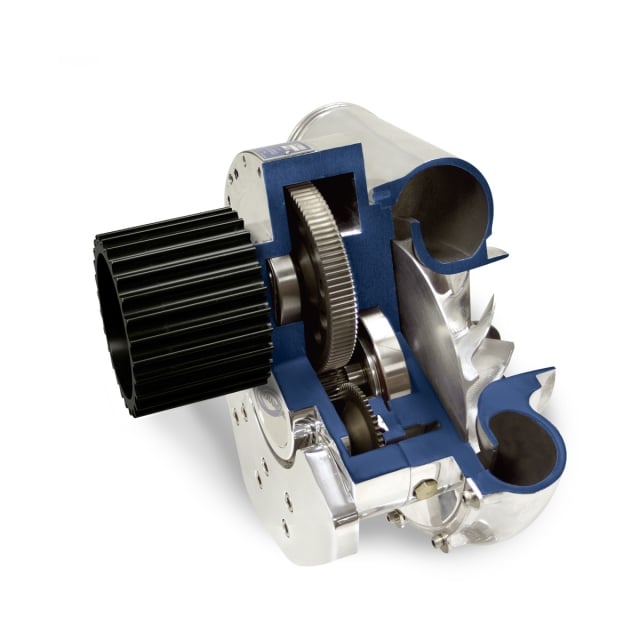
The bearing-within-a-bearing design of ProCharger’s F-Series supercharger helped the company to achieve incredible performances on the racetrack while retaining the reliability necessary to compete race after race.
For ProCharger, the largest gain has been seen in the design of the transmission and bearing assembly. The F-Series superchargers, which use a unique bearing-within-a-bearing design, permitted the company to spin their superchargers harder and faster to create more power, more reliably. “When the F-Series debuted, in the very first season, Don Walsh, Jr., Doug Mangrum, and Jim Summers all got into the six-second zone. The real magic for us was making a stronger gear case,” Jones said.
The use of billet impeller wheels is another innovation that has produced large gains. Since the wheel can be modeled in the computer without actually producing it, and then subsequently cut on a CNC machine without making a casting or huge run of parts, minute changes are able to be made and tested in the real-world to quantify changes.
Vortech’s Middlebrook explained, “The impellers we design today are done in a program called Concepts NREC, which is a couple hundred thousand dollars for the program itself. The impellers have a lot of compound curves, the inducer diameter, the outside diameter, the height of the blade at the exducer – once those are designed in Concepts, then we move them over to SolidWorks, and finally to a five-axis CAM (computer aided machining) program. From that, we are able to go from a pre-machined blank to the actual impeller.” In Vortech and Paxton’s case, their street superchargers use CNC-machined cast impellers, while their racing superchargers like the XB-105 use a billet impeller. In ProCharger’s case, all of their impellers since 1994 have been machined out of 7075 T-6 billet.
Vortech redesigned the transmission in their superchargers starting with the V-20 family (Xi, XB-105 and V-28 123). It’s a clean-sheet, completely different system that incorporates a 4.21:1 internal step-up ratio and unique impeller shaft support system that offers great durability while supporting impeller speeds necessary to support huge horsepower.
Interesting to note that Vortech superchargers are designed to be engine-oil-lubricated (or can be used with an external fabricated system), while ProCharger’s F-Series offerings all incorporate self-contained oiling: a difference in design, and two different successful solutions to the same problem – ensuring the supercharger’s transmission has enough of a clean, cool oil supply to support 70,000-plus RPM.
Another notable technological development has been the use of ram-air-style supercharger mounting. Originally pioneered with the ProCharger F-3A chain-drive offerings run by the likes of Don Walsh, Jr., Doug Mangrum, and others in the heyday of Pro 5.0, the chain-drive units allowed the placement of the supercharger’s inlet in the nose of the car like the turbo racers were using to draw in cool air from the high-pressure nose area.
However, that initial forward-facing supercharger innovation led to current crankshaft supercharger-drive systems like those from Chris Alston, ATF Speed, and The Supercharger Store. The reliability of these systems has offered a notable increase in power thanks to the friction reduction of removing the belt-drive system and the hole in the nose feeding the blower.
Air-to-water intercooling, and the use of in-car ice tanks and fluid transfer pumps, has also helped the racers to step up their game. With a constant stream of super-cool air being forced into the engine, the racers were able to make great strides on the tuning side of the equation, allowing for more timing and more fuel to be put into the program and increasing horsepower exponentially.
Fully-programmable fuel injection systems also deserve a place on this list, as they have not only helped to make the engine combinations more reliable through tightly-controlled mapping of operating conditions, but also improve consistency for the racer as those conditions can be datalogged and improved upon once the data has been reviewed.
The First Wave – Racers Who Put Centrifugal Superchargers On The Map
Former Paxton owner J.R. Granatelli has a long and storied history in racing; as the son of the late Joe Granatelli, Sr., he ran the family’s Paxton Products supercharger company for a number of years before selling it and starting Granatelli Motor Sports. JR worked (and raced, for many years) to prove out the Paxton products.
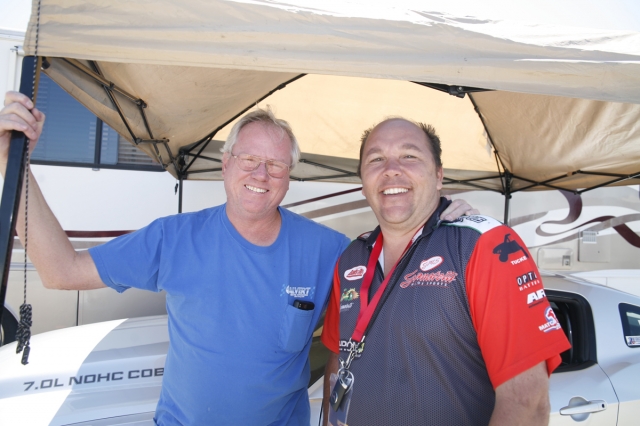
JR Granatelli (right) with legendary chassis-parts builder and racer John Calvert. Photo Credit: Rob Kinnan
His crowning achievement, back in 1994, was to develop and release the incredible NOVI-2000 supercharger, which, at the time, had a number of technological advancements that took the supercharger world by storm. It featured a set of quiet, helical-cut gears, and a newly-designed scroll and impeller design that was capable of producing 30 psi of boost and 1,000 horsepower while obtaining 50-state emissions legality – an incredible achievement for the time. Even today, no other centrifugal supercharger on the market makes that type of street-legal power.
In the mid- to late-1990’s, there was one racer running a Paxton supercharger in the Pro 5.0 class – George Greco, Jr. and his Paxton-supercharged Fox Body Mustang. Greco’s machine was the first car in the Paxton 8 Second Club while running a NOVI-2000 supercharger – with Granatelli’s help behind the scenes, George, Jr. driving the car and the Greco family building the engines at their engine shop, the “Rainbow Warrior” was one of the most feared machines on the planet at the time.
Way back at the very beginning, when the Fox Mustang wars were heating up on the East Coast, a New Jersey racer by the name of Craig Radovich was trying some pretty incredible things. Today, dual-supercharged machines have become more commonplace, but back then, building custom bracketry and stuffing a pair of Vortech A-Trim superchargers under the hood was an unheard-of feat. A bet from fellow racer Nitrous Pete Misinsky that it couldn’t be done set Radovich into motion, and he became the first racer to put a supercharged Mustang into the 9-second zone as a result.
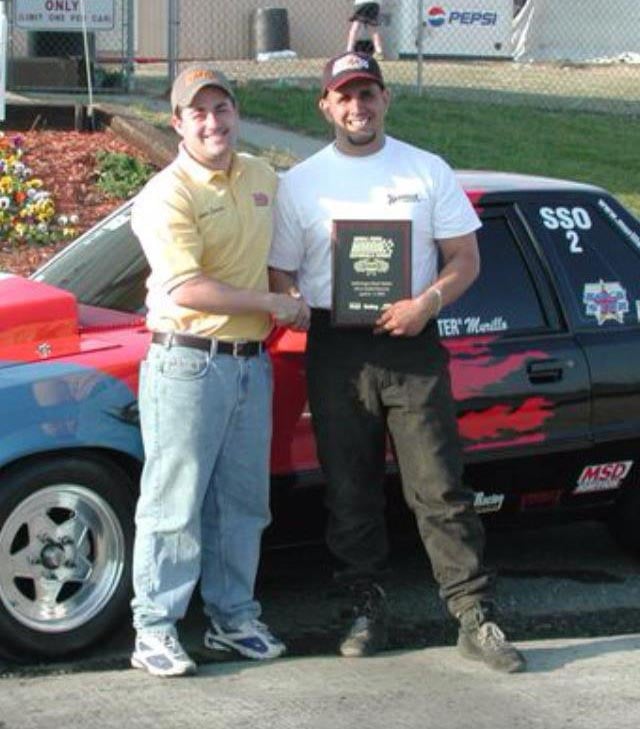
Before switching to the big-block and twin turbos he runs today, Mike Murillo took home a lot of Street Outlaw wins with a Vortech supercharger on board the original “Star Car”.
Mike Murillo began racing in Fun Ford Weekend’s Street Outlaw class all the way back in 1994, when you could still take a real street car and enter it into the class. Over the years, Murillo campaigned and won with a slew of Vortech-powered rides – a J-Trim and R-Trim both had their place under the hood of the “Star Car”. Over the next six years, Murillo won five separate championships in Street Outlaw with a Vortech supercharger, capturing his final “blower championship” with a Vortech XX-trim in 1999.
The Vortech team also included Louisiana racer Carlo Catalanotto, who had made a name for himself driving a number of New Orleans-based grudge-style cars over the years before transitioning into Bobby Dublan’s white LX for the 1997 Fun Ford season. Catalanotto piloted the car to the Street Outlaw class championship – with an XX-Trim Vortech on top. Catalanotto said, “Those years were absolutely crazy, man. Jim Summers kicked our asses all year long in 1997 – we were struggling to go 9.30’s and 20’s and Summers was just flying. We got lucky to win a couple of races through that season, and by the end of the year, we won the title, but Summers was the man. He just couldn’t put the race wins together.”
We didn’t want to just do what everyone else was doing, but wanted to create something that was substantially better, and so the D-Series was born. – Ken Jones, ProCharger
With Catalanotto’s championship title came the opportunity to work directly with Vortech on the XXX-Trim supercharger later on – which was never released to the public, as Catalanotto and the Keen brothers were the only people to have one.
Jimmy and Vic Keen went on in 1998 to turn in the first 7-second run in the Super Street 10.5 W-tire class, and they did it with a measly 347 cubic-inch stroker small-block Ford engine from Ronnie Crawford to go with their Vortech XX-Trim supercharger and Igloo intercooler, considered state of the art back then – products found today on real street cars! The Keen Brothers are still racing today – and won the ADRL Virginia event while competing in a ’63 Corvette in Pro Mod.
Also in 1998, Jim Summers was the first guy to put a Street Outlaw car (stock suspension, true 10.5” tire) into the eight-second zone in the ASSC Big Red 1 Mustang – running a Vortech J-Trim supercharger – and that performance catapulted Summers and ASSC shop owner Tim Huston into the consciousness of the racing world.
![derrick]](https://www.speednik.com/files/2013/03/derrick.jpg) At the time, ASSC was one of the nation’s leading performance shops thanks to the skills of Summers with the laptop – custom tuning, and aftermarket engine management systems were just starting to really take hold at that time, and Summers had a grasp on what it took to be successful. That talent led Summers to a Pro 5.0 driving gig with ASSC’s Big Red II and III, where he was one of the first Pro 5.0 racers into the sixes, along with Doug Mangrum and Don Walsh, Jr., and eventually a position with ProCharger as their Motorsports Director, cut short only by Jim’s passing in 2010.
At the time, ASSC was one of the nation’s leading performance shops thanks to the skills of Summers with the laptop – custom tuning, and aftermarket engine management systems were just starting to really take hold at that time, and Summers had a grasp on what it took to be successful. That talent led Summers to a Pro 5.0 driving gig with ASSC’s Big Red II and III, where he was one of the first Pro 5.0 racers into the sixes, along with Doug Mangrum and Don Walsh, Jr., and eventually a position with ProCharger as their Motorsports Director, cut short only by Jim’s passing in 2010.
1999 found the Mud Duck, Chris Derrick, attacking the new NMRA series with his multicolored Mustang.
“In 1999, Alan Dudley and Wayne Young of Young’s Performance talked me into taking the nitrous off my car and putting on a ProCharger D-3M. We made 1,575 horsepower on Wayne’s dyno back then. In 2000, we set the NMRA record at 8.19 at 177 MPH, and took home the World Ford Challenge’s Super Street Outlaw title the same season too,” Derrick says. “We were one of the ProCharger test cars and got to try lots of new stuff before everyone else got it. It seems like just yesterday – I can’t believe it’s been 13 years.” As one of the “Four Horsemen”, along with Dan Millen, Mike Murillo, and John Urist, Derrick was one of the most influential racers of his time.
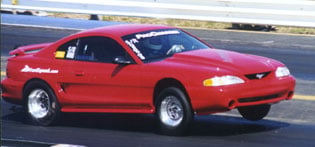 Also in 1999, ProCharger’s D-Series superchargers were kicking butt all over the place in the hands of noted tuner Jimmy LaRocca, who stuck a D-1R ProCharger making 30-plus pounds of boost onto Tommy Annunziata’s Mustang for the first World Ford Challenge and set the world on fire in the Renegade class. LaRocca put together a string of Renegade wins in both NMRA and Fun Ford competition in that car before moving over to the seat of Michael Freedman’s ’95 Cobra, where he set the World Ford Challenge Renegade record with an 8.86 at 156 MPH, and ultimately managing to get the F-1R supercharger outlawed in NMRA Renegade competition due to its performance advantage over the competition. LaRocca’s Performance was one of the great shops of the time as well, doing incredible things with the Ford EPEC system and others to help his customers perform at the track.
Also in 1999, ProCharger’s D-Series superchargers were kicking butt all over the place in the hands of noted tuner Jimmy LaRocca, who stuck a D-1R ProCharger making 30-plus pounds of boost onto Tommy Annunziata’s Mustang for the first World Ford Challenge and set the world on fire in the Renegade class. LaRocca put together a string of Renegade wins in both NMRA and Fun Ford competition in that car before moving over to the seat of Michael Freedman’s ’95 Cobra, where he set the World Ford Challenge Renegade record with an 8.86 at 156 MPH, and ultimately managing to get the F-1R supercharger outlawed in NMRA Renegade competition due to its performance advantage over the competition. LaRocca’s Performance was one of the great shops of the time as well, doing incredible things with the Ford EPEC system and others to help his customers perform at the track.
The Second Wave
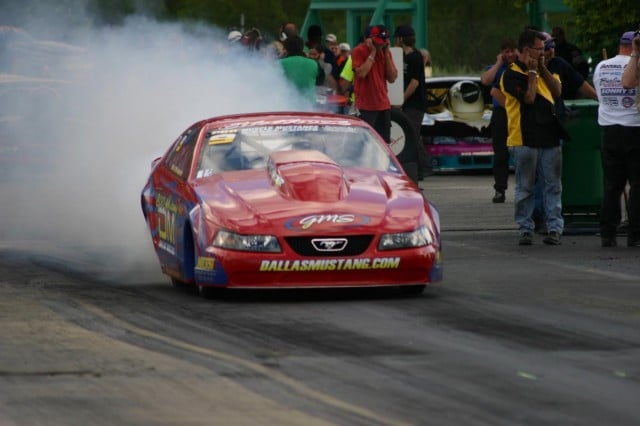
Doug Mangrum eventually drove his ProCharger F-3RR-equipped Mustang to an incredible 6.47 at 215 MPH in 2005 before retiring from the scene. Photo Credit: ProCharger
Racers like Texas-based Doug Mangrum broke huge milestones – as the first Pro 5.0 racer in the 7-second zone, he ignited the class and sparked the revolution that saw tube-frame cars appear in what had traditionally been a back-half only class. In April of 2001, Mangrum continued his success when he took his ProCharged 1996 Pro 5.0 Mustang GT into the record books by becoming the first Pro 5.0 racer to break into the 6-second zone with a 6.98 at 200 MPH on a qualifying pass in Atlanta during a Fun Ford Weekend event.
As the NMRA started heating up, and the “Ten Inch Tire Freak Show” Super Street Outlaw class captivated fans and racers alike, a number of innovators stepped up to fly the ProCharger banner. Most notable back in those early days was Floridian Jim Blair in his white ’95 Cobra R machine. With the help of crew chief Jason Gatlin of ATF Speed in Florida, Blair was able to set the Super Street Outlaw world on its ear when he set the record to a 7.80 at 180 MPH back in 2002 with an archaic ProCharger D-3M – a feat even Dan Jones of ProCharger didn’t believe was possible at the time. He and Gatlin spent hundreds of hours testing, and were subsequently able to take home the SSO season title with an F-3 supercharger in the 2004 season.
“I crewed for Ronnie Cox when Super Street Outlaw had that huge field in Columbus, and I realized I just had to be a part of what was happening. I went out to have fun, first and foremost. We had some success, and what I realized was the level of commitment that it took to be that successful – it takes over your life. I went into it just wanting to go fast, and then it became this intense exercise in being ready with every spare part in the world,” Blair said.
We built reliable equipment, and learned to tune the torque of the blower to get it off the line and apply it properly, and once you figured that out the rest of it was a matter of being able to go rounds. – Jim Blair
As a result of all of the testing that Blair did, Gatlin needed to fabricate a number of parts to help keep the engine alive and everything running smoothly – parts that were then offered to other racers running the big ProCharger combination. “We made six passes and had six broken belts, along with six broken hoods in a row. We also bent two crankshafts from the 14mm belts we were using. We won the 2004 championship with my doubler idler bracket setup, Billet belt guard assembly and crank support. All this was developed in-house in 2003, tested in 2004, then offered to other racers after 2004. In 2004 we never broke a belt the whole season,” Gatlin explained.
Although John Urist won his first Super Street Outlaw championship with a turbocharger, he quickly switched to the ProCharger when Blair showed its advantage and continued that association with ProCharger right up until the end of the 2012 season. Different cars, even different supercharger models thanks to rules changes – none of it fazed Urist, who made his reputation, earning a record seven Super Street Outlaw championships, thanks to the consistent performance his ProCharger provided him over the years.
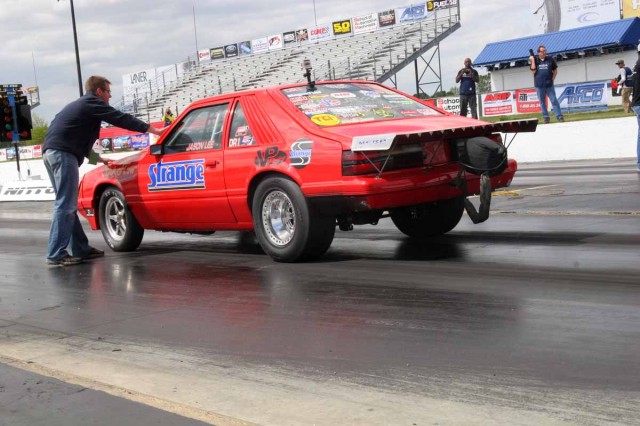
Back in 2009 Jason Lee became the first racer to break into the seven-second zone in NMRA Drag Radial competition with a ProCharger. Photo Credit – Mary Lendzion
Jason Lee spent four years as “the man” in the NMRA’s Drag Radial class, winning four consecutive championships with the help of an F-1R over the first three seasons, and later its successor, the F-1X, during the 2012 season. Lee became the first racer to reach the seven-second range on the notoriously-tricky class-spec BFGoodrich Drag Radial tire with a 7.97 in Bradenton, Florida, in March of 2009 – a milestone that racers with names like Kolivas, Tuten, Fiscus, and Klugger spent years chasing before Lee was finally able to do the deed. Lee’s ProCharged 360 cubic inch machine held the record in the final season of NMRA Drag Radial competition with a 7.36 at 190 MPH.
NSCA Limited Street competition had Brooklyn native “Mustang” Mike Modeste taking home six titles in his supercharged LX – he took home four of the five championships between 2000 and 2005, and tacked on two more titles in 2007. He’s also the fourth inductee in to the Six-Second Drag Radial club, which is an exclusive group of the best of the best – most of whom are turbocharged. Modeste can be found on the East Coast tearing up the track. His Mustang currently sports a pair of gear-driven ProCharger F-1X superchargers atop a self-built big-block Ford engine – and makes well north of 2,800 horsepower at full song.
EFI Renegade
Sidebar title
The Renegade Revolution
Because of the popularity of the Renegade classes both with the NMRA and Fun Ford Weekend, the street supercharger market saw a radical change. Initially the S-Trim Vortech supercharger was the standard for the class, but from there, the adoption of the Y-Trim and YS-Trim wheels led the class into the 9.50 range, along with the performance of the NOVI-2000. Then the YS supercharger was refined in 2003 to become the YSi-trim supercharger and returned Vortech to dominance atop the Renegade ranks. Meanwhile, ProCharger started out with a supercharger for the Renegade class initially with the F-1 design, which morphed over time into the F-1R design and all of the superchargers in between, all because of EFI Renegade. These superchargers are currently found all over the country in some of the most powerful street cars around.
As a result of the street revolution, the EFI Renegade class took shape, with racers like Bob Kurgan and Brian Mitchell along with others at the forefront of development. The Renegade class was unique in that is required the use of street-style superchargers equipped with serpentine-style belt drives, just like the multitudes of street cars roaming the country.
Mitchell, since the very first day of NMRA EFI Renegade (he’s missed only two races since 1998), has been running one of those superchargers.
“I ran a Vortech YS in the first couple of years of competition before switching to the Paxton NOVI-2000 for the 2002 and 2003 seasons, then went back to Vortech when the YSi came around. One of the biggest innovations we had in our class was the Vortech crank-to-blower brace – it allowed us to crank down on the belt to get more boost without fear of hurting the crankshaft. Then, later on, the Reichard Racing and Carbonite pulleys came around, and those have also been helpful in making power,” he explains. Mitchell currently holds the record for the quickest-ever Renegade pass, set last season with an 8.26 at 165 MPH – and five class championships to go along with it.
Kurgan battled with Mitchell for years in Renegade with his trusty ’86 GT T-Top car. He street-raced for years before moving into organized competition with Fun Ford’s Renegade class in 1998 before moving over to the NMRA, all with a Paxton NOVI-2000. After Vortech released their YS-Trim, Vortech asked Kurgan to make the switch, which he did, and he’s been Vortech-based ever since.
Kurgan says, “We needed to build a solid dual-plate bracket set with a screw tensioner for the YS-Trim before Vortech even had one, because we needed it to help tension the belt to make boost with the 8-rib drive that was required in EFI Renegade.” Kurgan Motorsports also took the Vortech crankshaft brace idea and innovated their own design, seen below. He eventually moved into NMRA Drag Radial and NMCA Xtreme Street with the Vortech Xi and XB-105 superchargers, and when we spoke with him he mentioned that the car had recently seen an engine-management system upgrade and would be back soon to compete in a variety of classes.
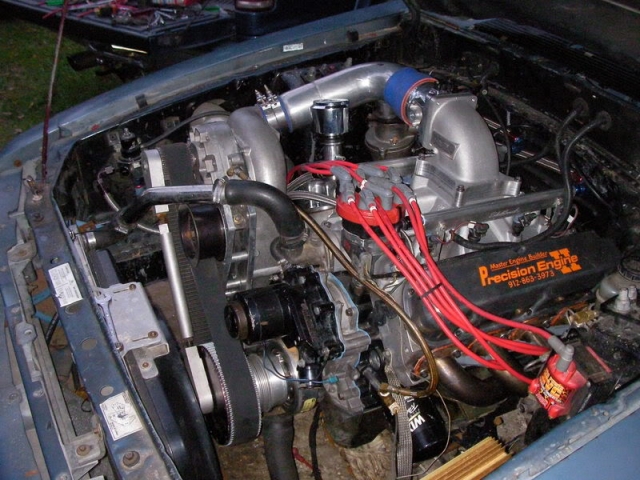
Much like the dual-plate bracket design, Kurgan Motorsports took one of Vortech’s designs – the crankshaft-to-blower brace – and redesigned it to withstand the rigors of EIF Renegade racing, as seen above. The brace is still available from Kurgan Motorsports and can be used with either a driver- or passenger-side mounted supercharger.
Current Affairs – The Third Wave
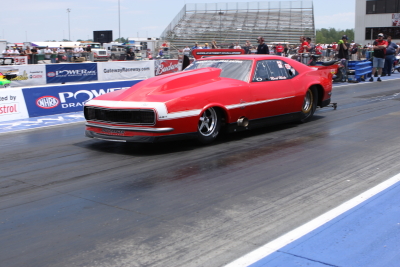 We’d be negligent if we didn’t mention a few of the most feared racers on the planet today. One racer who made a big impact on the supercharger world in more recent times is none other than Missouri’s Mark Micke. As one of the research and development platforms for ProCharger over the last several years, Micke has done tons of testing in a variety of different vehicles, most of which have been equipped with big-block Chevrolet engines, ProCharger F-3 superchargers, and alcohol in the fuel cell. As one of those research platforms, Micke had been involved with the F-3’s development since 2003, and ProCharger can credit some of the development work on their F-3R 135 and 139 superchargers, along with the F-4 project, to Micke’s race testing.
We’d be negligent if we didn’t mention a few of the most feared racers on the planet today. One racer who made a big impact on the supercharger world in more recent times is none other than Missouri’s Mark Micke. As one of the research and development platforms for ProCharger over the last several years, Micke has done tons of testing in a variety of different vehicles, most of which have been equipped with big-block Chevrolet engines, ProCharger F-3 superchargers, and alcohol in the fuel cell. As one of those research platforms, Micke had been involved with the F-3’s development since 2003, and ProCharger can credit some of the development work on their F-3R 135 and 139 superchargers, along with the F-4 project, to Micke’s race testing.
Micke took home the NMCA’s Pro Street title in 2008 with a ’67 Camaro while teamed up with Jeff Dickey, and in the same year won the Pro Mod class at the World Street Challenge, setting the record at the time as the quickest centrifugal-supercharged car in the world with a 6.25 at 227 MPH. Today Micke is driving Jason Carter’s twin-turbo 10.5 car in NMCA Super Street action.
Stevie “Fast” Jackson will always be remembered as the first racer to the four-teens on a drag radial tire. Jackson’s big-block Chevrolet combination sucked down an absolute ton of boost from the new ProCharger F-3R 136 supercharger – enough to click off a 4.19 at over 186 MPH in the eighth-mile, elapsed times and speeds nearing Pro Mod territory from a real, full-bodied doorslammer.
Back in 2012, just after breaking that four-teen mark, Jackson told us, “We had been dancing around the record all year long. We finally got the parts and pieces together to do it. I drove nine hours to set the record. After that pass I loaded her back in the box to come home.” The car is now owned by the Al-Anabi gang, and Jackson is driving it in ADRL Pro Drag Radial this season – where he took home the win over Micke in the first-ever Pro Drag Radial final round.
Also tearing up the track with a centrifugal-supercharged combination of late is California’s Doug Sikora and his 2003 home-built Mustang – which relies on a ProCharger F-3R 136 supercharger in front of a Brad Anderson -8 Hemi engine. Sikora recently wrecked the 10.5 record by leaps and bounds running in the Pro Street class at an NMCA West event, where he turned in an unbelievable 6.17 at 230.61 MPH – on a 10.5W tire! Sikora explained, “The car was 2,700 pounds, completely Super Street legal – we were just testing on a prepped track as it was the first time we’ve been able to get to one since the PSCA Record-Breaker Nationals.”
The New Jersey-based Bruder Brothers, Rich and Nick, have set the X275 world on fire over the last two seasons. Running first with the F-1R supercharger before changing over to the F-1X at the beginning of last season, the boys have been hurting feelings every chance they get. Since the end of last year, they’ve decided to switch over to a turbocharged combination, in an effort to quell the noise from those who feel they have only run quickly because of the F-1X – which has since been outlawed in X275 competition.
New Technology
Vortech’s XB-105 and V-28 123, along with ProCharger’s newest F-Series superchargers, most notably the record-setting F-1X and F-3R 136mm, are making serious noise in racing circles, and if past history is any indication of future performance, the gains realized through these companies’ R&D efforts on the racetrack will trickle down to their street supercharger customers, making the enthusiast world a better place for us all. As Ken Jones from ProCharger told us when we spoke with him about this article, “We’ve always felt that supercharging was a highly advantaged technology for high performance and would grow substantially. And there’s still plenty of room for more growth!”
The racing world has proven so thus far. As you can see, there is a long and storied history that the centrifugal supercharger – from a variety of manufacturers – has enjoyed in the heads-up racing ranks. There are dozens of racers and accomplishments that we couldn’t profile here due to space limitations, but we hope the walk down memory lane has been fun.



